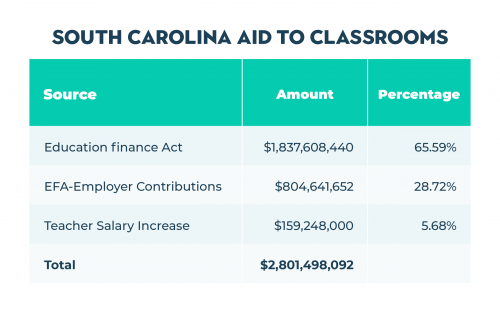What “base student cost” means and why it matters for SC students
Our post several weeks ago, “South Carolina public schools are not underfunded,” caused considerable blowback from the “just give us more money” sector. Now to be fair, the definition of “fully funding” our state’s public schools is tricky. So, in the interest of fairness, here’s an unvarnished revisiting of a key component of education funding: Base Student Cost.
Taken on its face, the term “Base Student Cost” should be just that, a base or foundational program that makes up most of the cost of educating an average child. That was the intention when the Base Student Cost concept was included in the Education Finance Act in 1977. BSC’s dominance in school funding may have represented a true foundation then, but it doesn’t anymore.
As recently as 1993, Base Student Cost provided 58% of state aid to school districts. It now provides only about 38% of state funding (or 18% of state, local and federal funding combined). EFA’s Base Student Cost is still the largest single source of funds, but the sum of property tax relief reimbursements, state grants, the Education Improvement Act, and the Education Lottery is now a majority of funds.
The state has not fully funded that 38% that comes from Base Student Cost in the last several years. But there are at least three factors to consider when determining whether the state is somehow cheating the schools out of BSC dollars. Those are: the method for calculating Base Student Cost and whether the state is counting all it spends on BSC type expenses.
- To update Base Student Cost for inflation each year, the state uses a combination of Southeastern school salaries and the Consumer Price Index. Are those measures appropriate? Or do they have the effect of overstating inflation/cost of living and therefore creating a false BSC funding gap?
- What about state spending on items such as employee benefits? That line has not been a part of the Base Student Cost number in the past. Why doesn’t the legislature get “credit” for funding that significant expense?
- The Base Student Cost figure that is reported is unweighted. Additional funds flow to the districts when weights are added for specific types of students (calculated as “Weighted Pupil Units” or “WPU”) depending on their characteristics (poverty, English Proficiency, dual credit enrollment, etc.). The increased total number of WPUs is another explanation for why the Base Student Cost hasn’t increased as much. WPUs have increased.
For these reasons in part is why in its 2019-2020 budget the South Carolina General Assembly “rolled up” several line items to provide a more accurate picture of what level of foundational aid to districts it is actually funding. As a new category called “State Aid to Classrooms, here is how it broke down:

For an estimated 720,316 students, Aid to Classrooms comes to $3,889 per student. This is a more accurate picture. That compares to an estimated Base Student Cost figure for 2019-2020 of $3,095.
Looking at the bigger picture, the average per student funding from all sources is projected to be $6,556 state, $1,315 federal, and $6,406 local. That is an average total funding level of $14,227. Here’s how that total funding compares to our Southeastern neighbors.
Clearly, we don’t need to spend more, we just need to spend smart! (Details here.)
One last point about Base Student Cost. We cannot ignore the fact that the lower the proportion of state education spending represented by EFA’s Base Student Cost, the lower the equity in the funding system. That’s why we have called for an EFA 2.0.
True school finance reform will roll up even more line items so that funding bureaucracy and programs will go down and Base Student Cost/Aid to Classrooms will become truly foundational again. That’s not liberal or conservative, it’s just plain fair.

